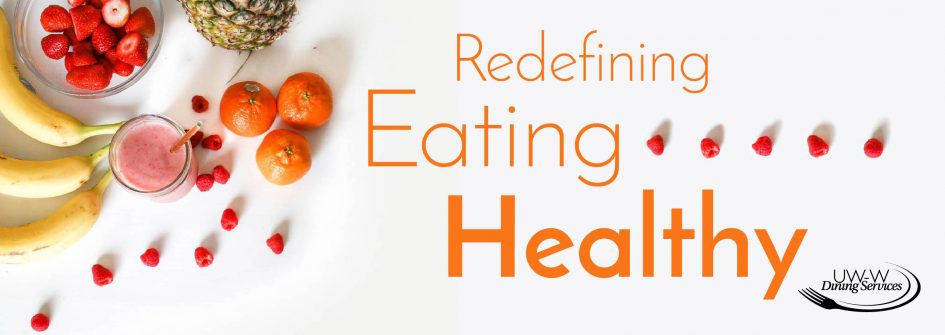The word “healthy” is a very ambiguous term and will be defined differently by anyone you talk to. Everyone has different bodies, tastes, backgrounds, and everyone’s “healthy” looks a little different too. Health is looked at as a holistic approach having multiple domains and the food you consume is just one part of it.
Foods shouldn’t be placed in categories of “good” and “bad” or not nutritious. A “bad” food will still contain carbohydrates, protein, fat, sugar, vitamin C, sodium, etc. All of which still nourish your body. No matter the vessel, you still need ALL these nutrients for your body to function correctly. Yes, some foods do contain higher amounts of essential nutrients in comparison to others, but there is no way daily needs are met through one food or type of food. In order to get all the nutrients, vitamins, and minerals you should be eating a variety of foods throughout your day. The MyPlate model is a great way to visualize variety and help you make food choices at meal time
Here is where the idea of moderation and portion size comes in. Too much of anything isn’t a good thing. You know you should drink water because it is categorized “good” for you but drinking too much water can be detrimental to your health. Same applies to how you eat. As you vary food and continuously pay attention to portion sizes, consuming a “bad” categorized food higher in demonized nutrients like fat or sugar, will not negatively affect your health. If anything, it will make you feel happy, content, or satisfied which is the ultimate goal when we eat.
Diet culture has led people to believe eating less is best or limiting certain food groups is okay. That is where the idea of “good” and “bad” foods has stemmed from. Eating shouldn’t be an anxiety driven experience. If you let go of negative language around food and focus on the two small ideas of variety and moderation, you are “eating healthy.” Feel free to personalize your plate at your next meal using these ideals and remember you are fueling your body with food that makes you feel good.
National Nutrition Month History Facts:
1- National Nutrition Month started out as National Nutrition Week back in 1973 featuring the theme “Invest in Yourself-Buy Nutrition”. The promotion for this nutrition week included a presidential proclamation, news releases, bumper stickers, and TV and radio public service announcements. This became the ‘most successful attempt to reach the public with sound nutrition information in a timely fashion.’
2-National Nutrition Month provides an opportunity to deliver nutrition education to the public. The theme each year has a different focus but each theme encourages healthful eating.
3- In 1977, Nutribird was introduced as an ‘animated mass media symbol of good nutrition’. Nutribird became the spokesperson for National Nutrition Month and was featured in many places including stickers, t-shirts, and other promotional items. The bird appeared in various educational shortclips, radio spots, and TV public service announcements. Unfortunately, Nutribird’s stay was not very long. By 1980 his role diminished due to dietetics members not feeling the bird was the right image for professionals.
4- National Nutrition Week had become so popular that the House of Delegates decided to expand National Nutrition Week to National Nutrition Month which began in 1980.
5- The 1980’s embraced National Nutrition Month and continued to grow in popularity each year. Promotional material started popping up all over the place including billboards, bus signs, milk cartons, grocery bags, and airplane banners. Posters even started appearing in military institutions around the world, including Navy submarines.
6- By 1987, National Nutrition Month promotional materials, including table tents and posters, made their debut on national television as information was featured in school cafeteria props on the show Head of the Class and Growing Pains.
7- The 1990’s era provided to be an eye opener for National Nutrition Month. Consumer trends and surveys were analyzed and the conclusion was drawn that although consumers are more concerned about their health, they were still confused on how to incorporate the knowledge being presented. This challenge shifted the focus to not just providing information, but calling consumers to take action. In 1992 the theme “Eat Right America” was born and continued for 3 years to help maximize impact and awareness. This theme was the inspiration behind the eatright.org website
8- Believe it or not, McDonalds and the American Dietetic Association partnered in 1993 to create a program called Food FUNdamentals. This project featured happy meal characters and nutrition activity handouts that were developed by the American Dietetic Association and were distributed to the more than 9,000 franchise locations. This program helped millions of children learn about the Food Pyramid Guide.
9- In 1995 there were concerns about mixed messages and consumer confusion so the American Dietetic Association joined members of the food industry, US government agencies, and other health organizations to create the Dietary Guidelines Alliance. The objective for this collaboration was to ‘speak with one voice’ so that consumers would receive consistent information. This developed the ‘It’s All About You’ campaign to help translate the Dietary Guideline Recommendations and make them easier to understand. This included: be realistic, be adventurous, be flexible, be sensible, be active. These concepts are still promoted today.
10-Today, National Nutrition Month is much more recognized and can be seen everywhere you look. From school nutrition programs to promoting nutrition in the corporate world, many resources are available at your fingertips. The sole purpose of National Nutrition Month still stands today, “To increase the public’s awareness of the importance of good nutrition and position American Dietetic Association members as the authorities in nutrition”
Written By: Jessie Glanz (Dietetic Intern)

Leave a Reply